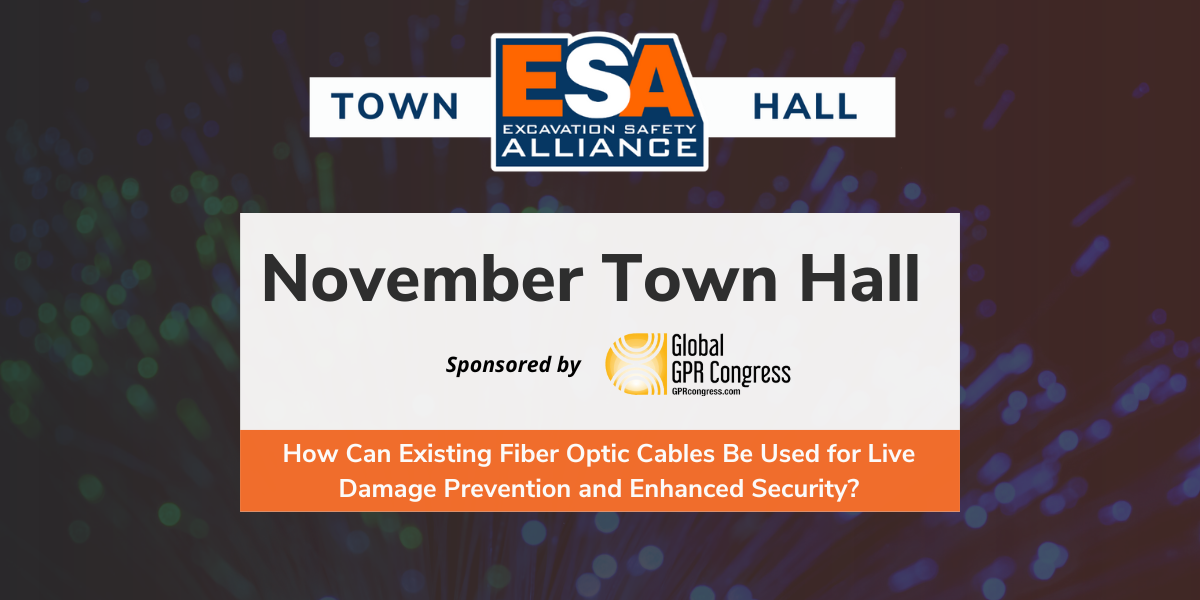
Hello Readers,
In our recent Town Hall, sponsored by the Global GPR Congress, industry leaders shared their insights into the revolutionary domain of fiber optic sensing technology. Across the globe, this technology is playing a pivotal role in monitoring intelligent infrastructure such as tunnels, railways, bridges, borders, power stations, and pipelines. Its applications extend to the continuous monitoring of various parameters, including vehicle movement, human traffic, digging activity, seismic events, structural health, temperatures, liquid and gas leaks, among other conditions and activities.
This particular discussion zeroed in on the challenges related to digging activity and the hurdles faced by the existing 811 system.
Our participants included:
• Scott Landes, CEO, Excavation Safety Alliance (Moderator)
• Paul Dickinson, Director of Business Development, Dura-Line
• Michael Montgomery, Manager of Applications Engineering, AP Sensing
• JJ Williams, Global Commercial Director, LUNA Innovations
• Kyle VanLandingham, Director of Business Development, Texas811
The 811 system faces a complex set of challenges in its current operational landscape. Notably, there is a lack of decreasing damages within the industry, reflecting an ongoing concern. Locators are grappling with declining on-time rates, struggling to meet targets efficiently. The core issue does not seem to be a lack of awareness of the 811 system; rather, the industry grapples with a trade-off between prioritizing speed and efficiency over comprehensive damage prevention practices. The misalignment of incentives results in a scenario where there is minimal motivation to adhere to best practices, leading to the adoption of shortcuts.
In response to these challenges, there is a pressing need for innovative solutions within the 811 system. Traditional outreach methods, while valuable, may no longer yield the same return on investment. Additionally, the current juncture presents an opportune moment for the industry to embrace innovation wholeheartedly. Exploring and integrating new technologies can redefine the landscape of damage prevention, paving the way for more effective and sustainable practices.
The Fiber Optic Sensing Association (FOSA), established in Washington DC in 2017, is a non-profit organization with a mission to educate industry stakeholders, government bodies, and the public about the benefits of fiber optic sensing. Operating by measuring changes in the backscattering of light within an optical fiber, fiber optic sensing provides real-time information by serving as a sensor along its entire length. This technology is instrumental in pinpointing the precise location of events and conditions along the sensor cable.
Live right-of-way (ROW) monitoring via fiber optic sensing technology may be one of the missing pieces to the damage prevention puzzle. Optical cables in the ROW act as latent sensors waiting to be activated. Live ROW monitoring involves continuously tracking the return signal for vibrations, strain, and temperature around the fiber, promptly reporting to operators with GIS.
Our audience had their questions at the ready after learning the fundamentals of this technology. Here were several that contributed to a lively discussion about the use of this technology within the damage prevention industry:
• So, in new construction would this be in addition to or in place of installing tracer wire/tape with an asset?
• With the majority of new utility asset installations via HDD, creating issues with tracer wire installations, has FOSA any recommendations on installations processes to reduce excessive bending or flexing of the designated "sensor" fiber?
Continuing the Conversation: For those who missed the live Town Hall, we encourage you to watch the full video here. Also, to review all the discussions that were had in the chat, please view chat log here.
Upcoming Town Hall: Mark your calendars for our next Town Hall on December 14th, where we'll explore "What Are the Best Ways to Use Vacuum Excavation to Prevent Damage, Create Accurate Maps, and as a Part of SUE?" Join us in unraveling innovative strategies and contributing to this vital conversation. Click here to register.
Supporting Companies Make it Possible:
We are grateful to the supporting companies that make our initiatives, like the Town Halls, possible. These organizations play an instrumental role in advancing excavation safety and damage prevention. To learn more about how you can become a supporting company, please visit this link.
Halls, possible. These organizations play an instrumental role in advancing excavation safety and damage prevention. To learn more about how you can become a supporting company, please visit this link.
Stay tuned for more updates and insights, and thank you for joining us in championing safety and fostering collaboration in the field of damage prevention. See you at our next Town Hall!
